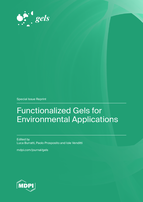Functionalized Gels for Environmental Applications
A special issue of Gels (ISSN 2310-2861). This special issue belongs to the section "Gel Applications".
Deadline for manuscript submissions: closed (10 September 2023) | Viewed by 25972
Special Issue Editors
Interests: material science; hydrogels; water remediation; optical properties of materials; noble metal nanomaterials; 3D photo-printing
Special Issues, Collections and Topics in MDPI journals
Interests: optical sensors; silver nanoparticles; surface plasmon resonance; optical absorption; heavy metal ions; hybrid solgel based films; fluorescencent waveguides; 3D printing
Special Issues, Collections and Topics in MDPI journals
Interests: nanomaterials; inorganic chemistry; drug delivery; sensing; optical materials; photonics
Special Issues, Collections and Topics in MDPI journals
Special Issue Information
Dear Colleagues,
As Guest Editors of the Special Issue “Functionalized Gels for Environmental Applications” in Gels, we would like to invite you to contribute to its success. Based on your valuable expertise in this research field, we are confident that you can submit a manuscript that meets the journal’s criteria for significance and scientific excellence.
This Special Issue is dedicated to the synthesis, characterization, and application of functionalized or doped matrices (e.g., hydrogels, aerogels or sol–gels) for environmental purposes such as the sensing or removal of different toxic analytes. The chemical functional groups or the doping materials such as noble metal nanostructures, quantum dots, carbon nanotubes, etc. play several roles, donating further features to the host matrix such as particular optical, mechanical or electrical properties, and interacting with the surrounding environment. In addition, the employment of hosting matrices increases the handling and portability, and opens new horizons for in situ environmental applications.
Experimental and theoretical scientific research in environmental applications are warmly welcome.
Dr. Luca Burratti
Dr. Paolo Prosposito
Prof. Dr. Iole Venditti
Guest Editors
Manuscript Submission Information
Manuscripts should be submitted online at www.mdpi.com by registering and logging in to this website. Once you are registered, click here to go to the submission form. Manuscripts can be submitted until the deadline. All submissions that pass pre-check are peer-reviewed. Accepted papers will be published continuously in the journal (as soon as accepted) and will be listed together on the special issue website. Research articles, review articles as well as short communications are invited. For planned papers, a title and short abstract (about 100 words) can be sent to the Editorial Office for announcement on this website.
Submitted manuscripts should not have been published previously, nor be under consideration for publication elsewhere (except conference proceedings papers). All manuscripts are thoroughly refereed through a single-blind peer-review process. A guide for authors and other relevant information for submission of manuscripts is available on the Instructions for Authors page. Gels is an international peer-reviewed open access monthly journal published by MDPI.
Please visit the Instructions for Authors page before submitting a manuscript. The Article Processing Charge (APC) for publication in this open access journal is 2600 CHF (Swiss Francs). Submitted papers should be well formatted and use good English. Authors may use MDPI's English editing service prior to publication or during author revisions.
Keywords
- functionalized matrices
- doped matrices
- gels
- noble metal nanoparticles
- noble metal nanoclusters
- quantum dots
- sensing
- remediation of environment
- heavy metal ions
- pesticides
- toxic gaseous compounds
Related Special Issue
- Functionalized Gels for Environmental Applications (2nd Edition) in Gels (4 articles)









